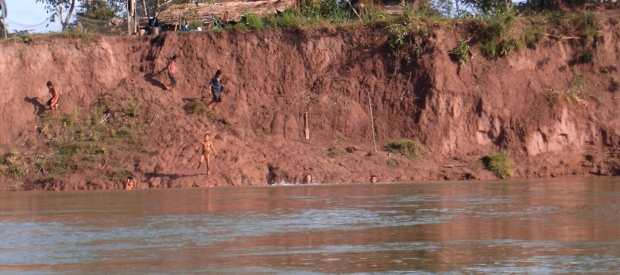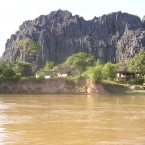Theun-Hinboun Dam and Expansion Project
"[Before the dam] I used to be able to earn 100,000 kip from one hour's fishing. Now I must work hard all day for [the plantation company] to earn 20,000 kip."
Fisherman from Ban Nong Boua, along the Hinboun River, 2007.
When the Theun-Hinboun Hydropower Project in
The project diverts water from the Theun to the Hai and Hinboun Rivers (see map), causing serious erosion and flooding in these river basins. Many villagers living along the Hai and Hinboun Rivers have abandoned wet-season rice fields because the floods have made rice cultivation unviable. The flooding has also caused water contamination, livestock deaths and other hardships for villagers living downstream. Alarmingly, water fluctuations have reportedly resulted in the death of several people. But THPC’s mitigation and compensation program started too late and has done too little to address these impacts, ignoring the recommendations of a review the company itself commissioned.
The Theun-Hinboun Power Company is a joint venture between the Government of Laos, Norwegian state-owned company Statkraft and GMS Power of Thailand. Although the project has made villagers poorer, it has generated windfall profits for its shareholders. Located downstream from the Nam Theun 2 Dam, Theun-Hinboun's earnings were boosted by the long delays in Nam Theun 2's implementation. To make up for the reduced water flows caused by Nam Theun 2 and to increase profits, the company built second dam on the
International Rivers is closely monitoring the situation of affected communities, particularly those located downstream. We are calling on THPC to ensure villagers who have been displaced by their projects receive full remedial support until their livelihoods have been restored. We also have issued several letters to THPC, urging them to establish an international monitoring system in line with the guidelines set out by the World Commission on Dams, including making a commitment to ensure the monitoring reports are publicly accessible in Lao and English languages.
THPC has now set up a Panel of Experts to monitor the expansion project. As of November 2015, THPC has failed to disclose an update about the panel's initial "orientation" visit that evidently took place in February 2015. THPC has also not provided information about the actual date of the first monitoring mission and tentative release of their report. However, according to company correspondence with International Rivers, the panel will undertake a full mission either at the end of 2015 or early 2016. In the meantime, we will continue to call on the company to fully disclose information about - and resulting from - the monitoring process.
- Read the latest analysis of the situation downstream of the Theun-Hinboun Expansion Project
- Read the report on the Theun-Hinboun Expansion Project: Expanding Failure
- Watch our video : Still Waters, Deep Troubles (8 min.)
- Read an article in The Guardian online edition about Norwegian involvement in Theun-Hinboun (September 24, 2008).
- Read International Rivers' report Power Surge: The Impacts of Rapid Dam Development in Laos.







